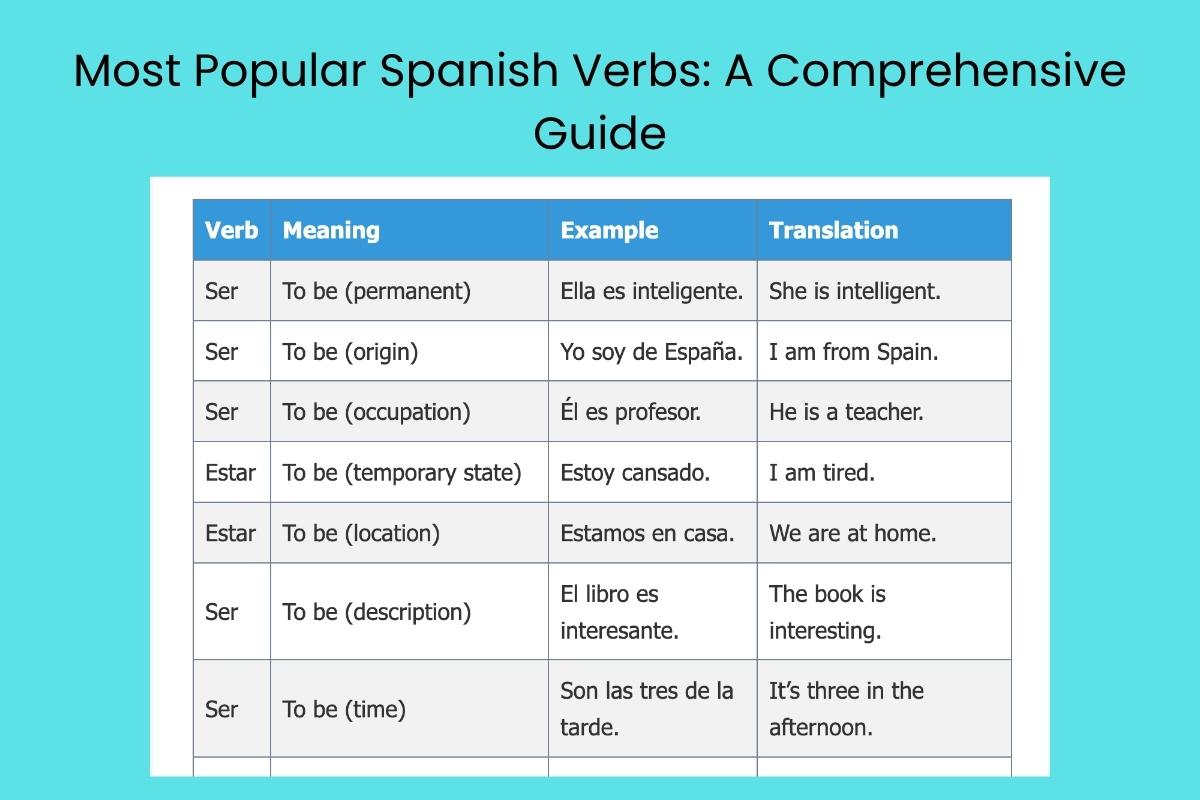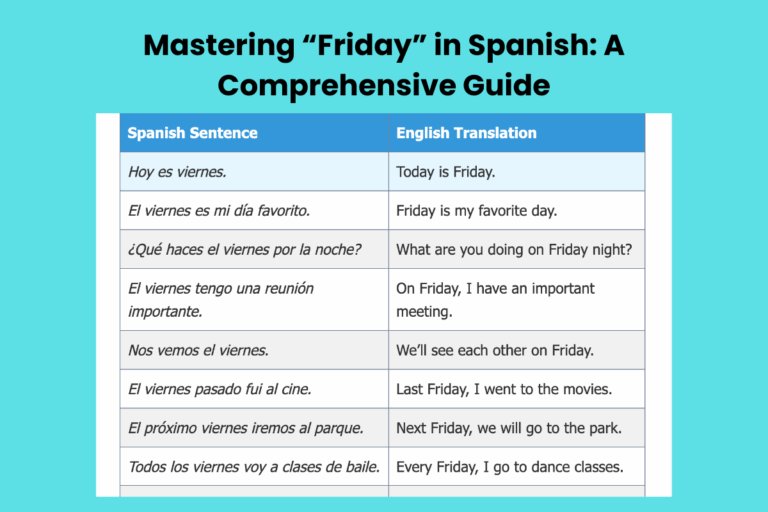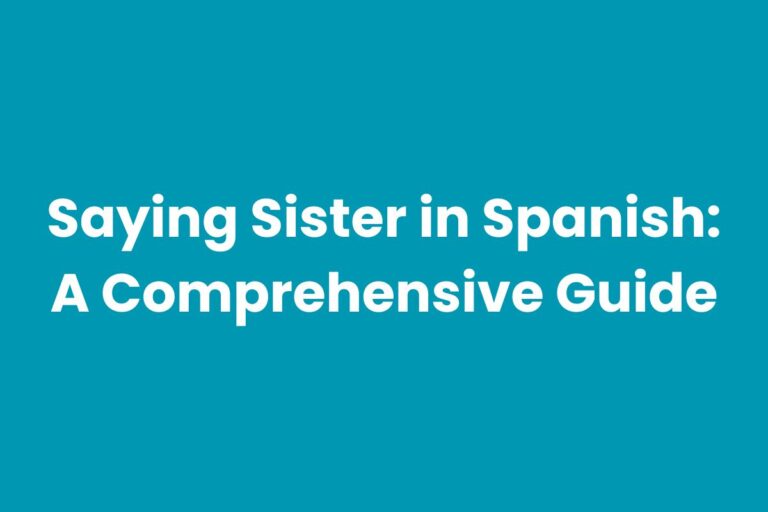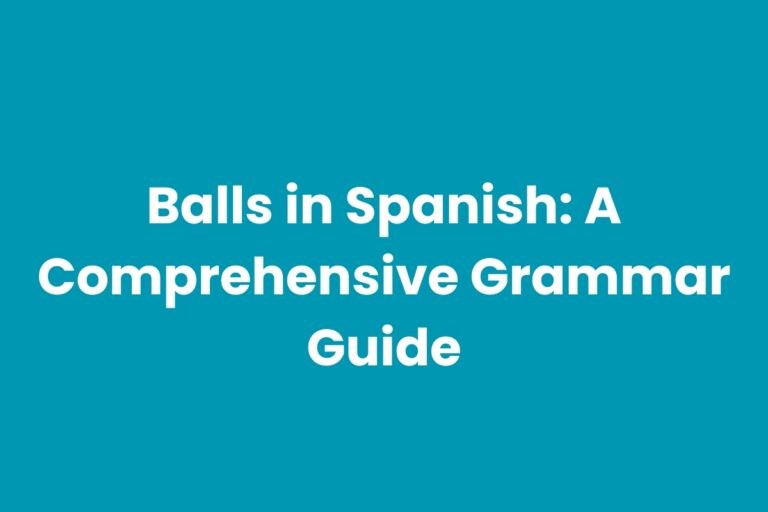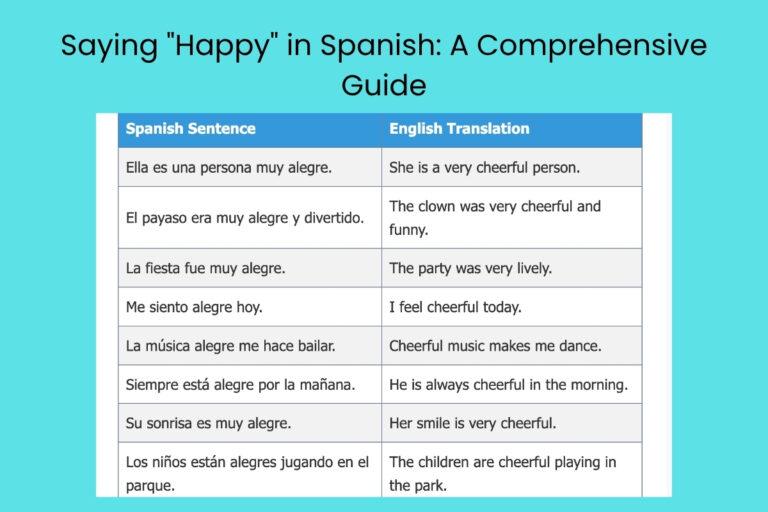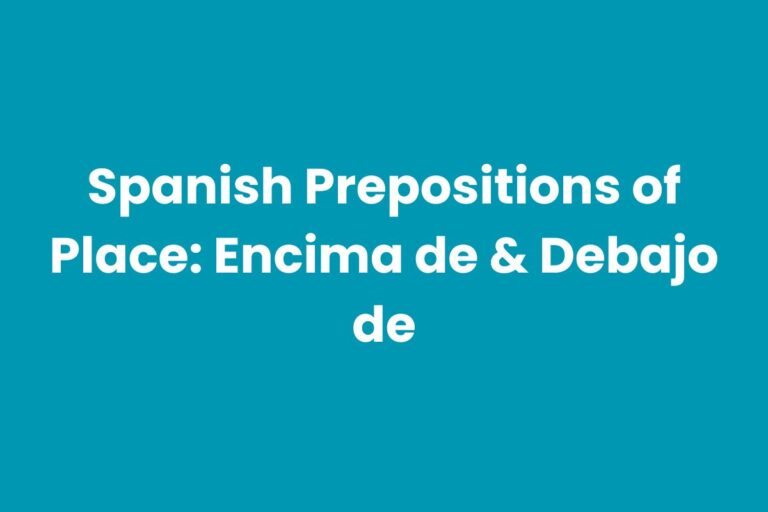Most Popular Spanish Verbs: A Comprehensive Guide
Understanding the most frequently used Spanish verbs is crucial for anyone learning the language. These verbs form the backbone of everyday communication and are essential for building fluency.
Mastering these verbs allows learners to express a wide range of ideas and participate in conversations more effectively. This guide provides a comprehensive overview of these verbs, their conjugations, uses, and common mistakes to avoid.
Whether you’re a beginner or an intermediate learner, this article will help you solidify your understanding and improve your Spanish language skills.
This article is designed for students, travelers, and anyone interested in learning or improving their Spanish. By focusing on the most commonly used verbs, we aim to provide a practical and efficient approach to language acquisition.
Learning these verbs will enable you to construct sentences, understand conversations, and express yourself confidently in Spanish.
Table of Contents
- Introduction
- Definition of Spanish Verbs
- Structural Breakdown of Spanish Verbs
- Types and Categories of Spanish Verbs
- Examples of Popular Spanish Verbs
- Usage Rules for Spanish Verbs
- Common Mistakes with Spanish Verbs
- Practice Exercises
- Advanced Topics in Spanish Verbs
- Frequently Asked Questions
- Conclusion
Definition of Spanish Verbs
In Spanish, a verb (verbo) is a word that expresses an action, occurrence, or state of being. Verbs are the core of any sentence, providing crucial information about what is happening or the condition of the subject. They are inflected to indicate tense (present, past, future), mood (indicative, subjunctive, imperative), person (yo, tú, él/ella/usted, nosotros, vosotros, ellos/ellas/ustedes), and number (singular, plural). Understanding how verbs function is fundamental to mastering Spanish grammar.
Spanish verbs are classified based on their infinitive endings: -ar, -er, and -ir. This classification helps determine the conjugation patterns for each verb. For instance, regular verbs follow predictable conjugation rules based on their infinitive ending. Irregular verbs, however, deviate from these patterns and must be memorized individually. Both regular and irregular verbs are essential for effective communication in Spanish.
The function of a verb in a sentence is to provide the action or state of being related to the subject. Without a verb, a sentence is incomplete. Verbs can also be modified by adverbs, which provide additional information about how, when, where, or to what extent the action is performed. In addition to indicating actions, verbs can also express states of being (e.g., ser and estar), which are crucial for describing characteristics and conditions.
Structural Breakdown of Spanish Verbs
The structure of a Spanish verb can be broken down into two main parts: the root (or stem) and the ending. The root carries the core meaning of the verb, while the ending indicates the tense, mood, person, and number. For example, in the verb hablar (to speak), the root is habl-, and the ending is -ar.
To conjugate a verb, you typically remove the infinitive ending (-ar, -er, or -ir) and add the appropriate ending for the desired tense and person. For regular verbs, these endings follow predictable patterns. For example, the present tense conjugations of hablar are: yo hablo, tú hablas, él/ella/usted habla, nosotros hablamos, vosotros habláis, ellos/ellas/ustedes hablan. Each ending corresponds to a specific pronoun.
Understanding the structural elements of Spanish verbs allows learners to deconstruct and conjugate them more effectively. By recognizing the root and the ending, it becomes easier to identify the verb’s meaning and its grammatical function in a sentence.
This knowledge is particularly helpful when dealing with irregular verbs, as recognizing the irregular patterns becomes crucial.
Types and Categories of Spanish Verbs
Spanish verbs can be categorized into several types based on their conjugation patterns and behavior. The main categories include regular verbs, irregular verbs, reflexive verbs, stem-changing verbs, and modal verbs.
Each category has distinct characteristics and conjugation rules that learners need to understand.
Regular Verbs
Regular verbs are those that follow predictable conjugation patterns in all tenses. These verbs are the easiest to learn because their endings remain consistent. The three main types of regular verbs are -ar, -er, and -ir verbs. For each type, the endings change according to the tense and person, but the root of the verb remains unchanged (except for some spelling changes to maintain pronunciation).
For example, the verb cantar (to sing) is a regular -ar verb. Its present tense conjugations are: yo canto, tú cantas, él/ella/usted canta, nosotros cantamos, vosotros cantáis, ellos/ellas/ustedes cantan. Similarly, comer (to eat) is a regular -er verb, and vivir (to live) is a regular -ir verb. Mastering regular verbs provides a solid foundation for learning more complex verb forms.
Irregular Verbs
Irregular verbs do not follow the standard conjugation patterns. Their roots or endings change in unpredictable ways, and they must be memorized individually. Some of the most common irregular verbs include ser, estar, tener, ir, and hacer. These verbs are frequently used, making it essential to learn their irregular conjugations.
For instance, the verb ser (to be) has the following present tense conjugations: yo soy, tú eres, él/ella/usted es, nosotros somos, vosotros sois, ellos/ellas/ustedes son. As you can see, these conjugations do not follow a regular pattern. Recognizing and memorizing these irregular forms is crucial for accurate and fluent communication.
Reflexive Verbs
Reflexive verbs are used when the subject of the verb performs an action on themselves. These verbs are identified by the reflexive pronoun se attached to the infinitive form (e.g., lavarse – to wash oneself). When conjugating a reflexive verb, the reflexive pronoun must agree with the subject of the sentence.
For example, the verb lavarse (to wash oneself) is conjugated as follows in the present tense: yo me lavo, tú te lavas, él/ella/usted se lava, nosotros nos lavamos, vosotros os laváis, ellos/ellas/ustedes se lavan. The reflexive pronouns (me, te, se, nos, os, se) indicate that the action is performed on the subject.
Stem-Changing Verbs
Stem-changing verbs undergo a change in the root vowel in certain conjugations. These changes typically occur in the present tense and sometimes in the preterite tense. The most common types of stem changes are e → ie, o → ue, and e → i. Understanding these patterns is essential for accurate conjugation.
For example, the verb pensar (to think) is a stem-changing verb with the pattern e → ie. Its present tense conjugations are: yo pienso, tú piensas, él/ella/usted piensa, nosotros pensamos, vosotros pensáis, ellos/ellas/ustedes piensan. Notice how the e in the root changes to ie in all forms except nosotros and vosotros.
Modal Verbs
Modal verbs (also known as auxiliary verbs) are used to express ability, obligation, permission, or possibility. The most common modal verbs in Spanish are poder (to be able to), deber (to ought to/should), querer (to want to), and tener que (to have to). These verbs are typically followed by an infinitive.
For instance, the verb poder (to be able to) is used to express ability. For example, “Yo puedo hablar español” (I can speak Spanish). Modal verbs add nuance to sentences and are essential for expressing a wide range of meanings.
Examples of Popular Spanish Verbs
This section provides detailed examples of some of the most popular Spanish verbs, including their conjugations and usage in sentences. Understanding these verbs is crucial for building a strong foundation in Spanish.
Ser and Estar
Ser and estar both mean “to be” in English, but they are used in different contexts. Ser is used to describe permanent or inherent characteristics, while estar is used to describe temporary states or conditions.
The following table provides examples of using ser and estar:
| Verb | Meaning | Example | Translation |
|---|---|---|---|
| Ser | To be (permanent) | Ella es inteligente. | She is intelligent. |
| Ser | To be (origin) | Yo soy de España. | I am from Spain. |
| Ser | To be (occupation) | Él es profesor. | He is a teacher. |
| Estar | To be (temporary state) | Estoy cansado. | I am tired. |
| Estar | To be (location) | Estamos en casa. | We are at home. |
| Ser | To be (description) | El libro es interesante. | The book is interesting. |
| Ser | To be (time) | Son las tres de la tarde. | It’s three in the afternoon. |
| Ser | To be (relationship) | Ella es mi hermana. | She is my sister. |
| Estar | To be (feeling) | Está feliz. | He/She is happy. |
| Estar | To be (condition) | La puerta está abierta. | The door is open. |
| Ser | To be (material) | La mesa es de madera. | The table is made of wood. |
| Ser | To be (event location) | La fiesta es en mi casa. | The party is at my house. |
| Ser | To be (possession) | El coche es mío. | The car is mine. |
| Estar | To be (health) | Estoy enfermo. | I am sick. |
| Estar | To be (result of an action) | La cena está hecha. | Dinner is ready. |
| Ser | To be (purpose) | El vaso es para agua. | The glass is for water. |
| Ser | To be (price) | El libro es caro. | The book is expensive. |
| Ser | To be (identity) | Soy estudiante. | I am a student. |
| Estar | To be (with gerund – progressive) | Estoy estudiando. | I am studying. |
| Estar | To be (appearance) | Estás muy guapo hoy. | You look very handsome today. |
| Ser | To be (characteristic) | Madrid es grande. | Madrid is big. |
| Ser | To be (date) | Hoy es lunes. | Today is Monday. |
| Ser | To be (nationality) | Somos italianos. | We are Italians. |
| Estar | To be (mood) | Estamos enfadados. | We are angry. |
| Estar | To be (weather) | Está lloviendo. | It is raining. |
Tener
Tener means “to have” in English. It is an irregular verb and is used to express possession, age, and obligation.
The following table provides examples of using tener:
| Pronoun | Conjugation | Example | Translation |
|---|---|---|---|
| Yo | Tengo | Yo tengo un coche. | I have a car. |
| Tú | Tienes | Tú tienes razón. | You are right. |
| Él/Ella/Usted | Tiene | Él tiene veinte años. | He is twenty years old. |
| Nosotros | Tenemos | Nosotros tenemos hambre. | We are hungry. |
| Vosotros | Tenéis | Vosotros tenéis suerte. | You (plural, informal) are lucky. |
| Ellos/Ellas/Ustedes | Tienen | Ellos tienen una casa grande. | They have a big house. |
| Yo | Tengo | Tengo que estudiar. | I have to study. |
| Tú | Tienes | Tienes que trabajar. | You have to work. |
| Él/Ella/Usted | Tiene | Ella tiene sueño. | She is sleepy. |
| Nosotros | Tenemos | Tenemos sed. | We are thirsty. |
| Vosotros | Tenéis | Tenéis prisa. | You (plural, informal) are in a hurry. |
| Ellos/Ellas/Ustedes | Tienen | Tienen miedo. | They are scared. |
| Yo | Tengo | Tengo un problema. | I have a problem. |
| Tú | Tienes | Tienes una idea. | You have an idea. |
| Él/Ella/Usted | Tiene | Él tiene un perro. | He has a dog. |
| Nosotros | Tenemos | Tenemos un coche nuevo. | We have a new car. |
| Vosotros | Tenéis | Vosotros tenéis muchos amigos. | You (plural, informal) have many friends. |
| Ellos/Ellas/Ustedes | Tienen | Tienen mucho dinero. | They have a lot of money. |
| Yo | Tengo | Tengo calor. | I am hot. |
| Tú | Tienes | Tienes frío. | You are cold. |
| Él/Ella/Usted | Tiene | Ella tiene razón. | She is right. |
| Nosotros | Tenemos | Tenemos cuidado. | We are careful. |
| Vosotros | Tenéis | Tenéis cuidado. | You (plural, informal) are careful. |
| Ellos/Ellas/Ustedes | Tienen | Tienen celos. | They are jealous. |
Hacer
Hacer means “to do” or “to make” in English. It is an irregular verb and is used in a variety of contexts, including making objects, performing actions, and talking about the weather.
The following table provides examples of using hacer:
| Pronoun | Conjugation | Example | Translation |
|---|---|---|---|
| Yo | Hago | Yo hago la cena. | I make dinner. |
| Tú | Haces | Tú haces ejercicio. | You exercise. |
| Él/Ella/Usted | Hace | Él hace un pastel. | He makes a cake. |
| Nosotros | Hacemos | Nosotros hacemos un viaje. | We take a trip. |
| Vosotros | Hacéis | Vosotros hacéis deporte. | You (plural, informal) play sports. |
| Ellos/Ellas/Ustedes | Hacen | Ellos hacen la tarea. | They do homework. |
| Yo | Hago | Hago frío. | I am cold (idiomatic). |
| Tú | Haces | Haces calor. | You are hot (idiomatic). |
| Él/Ella/Usted | Hace | Hace buen tiempo. | The weather is good. |
| Nosotros | Hacemos | Hacemos una fiesta. | We throw a party. |
| Vosotros | Hacéis | Vosotros hacéis preguntas. | You (plural, informal) ask questions. |
| Ellos/Ellas/Ustedes | Hacen | Hacen planes. | They make plans. |
| Yo | Hago | Hago la cama. | I make the bed. |
| Tú | Haces | Tú haces un favor. | You do a favor. |
| Él/Ella/Usted | Hace | Él hace lo posible. | He does his best. |
| Nosotros | Hacemos | Nosotros hacemos la compra. | We do the shopping. |
| Vosotros | Hacéis | Vosotros hacéis un esfuerzo. | You (plural, informal) make an effort. |
| Ellos/Ellas/Ustedes | Hacen | Hacen ruido. | They make noise. |
| Yo | Hago | Hago deporte. | I do sports. |
| Tú | Haces | Tú haces progresos. | You make progress. |
| Él/Ella/Usted | Hace | Él hace un dibujo. | He makes a drawing. |
| Nosotros | Hacemos | Nosotros hacemos un trato. | We make a deal. |
| Vosotros | Hacéis | Vosotros hacéis un viaje. | You (plural, informal) take a trip. |
| Ellos/Ellas/Ustedes | Hacen | Hacen una película. | They make a movie. |
Ir
Ir means “to go” in English. It is an irregular verb and is used to express movement or destination.
The following table provides examples of using ir:
| Pronoun | Conjugation | Example | Translation |
|---|---|---|---|
| Yo | Voy | Yo voy al cine. | I am going to the cinema. |
| Tú | Vas | Tú vas a la playa. | You are going to the beach. |
| Él/Ella/Usted | Va | Él va al trabajo. | He is going to work. |
| Nosotros | Vamos | Nosotros vamos a casa. | We are going home. |
| Vosotros | Vais | Vosotros vais a la fiesta. | You (plural, informal) are going to the party. |
| Ellos/Ellas/Ustedes | Van | Ellos van al supermercado. | They are going to the supermarket. |
| Yo | Voy | Voy a estudiar. | I am going to study. |
| Tú | Vas | Vas a comer. | You are going to eat. |
| Él/Ella/Usted | Va | Ella va a dormir. | She is going to sleep. |
| Nosotros | Vamos | Vamos a bailar. | We are going to dance. |
| Vosotros | Vais | Vais a cantar. | You (plural, informal) are going to sing. |
| Ellos/Ellas/Ustedes | Van | Van a jugar. | They are going to play. |
| Yo | Voy | Voy de compras. | I am going shopping. |
| Tú | Vas | Vas de viaje. | You are going on a trip. |
| Él/Ella/Usted | Va | Él va de excursión. | He is going on a hike. |
| Nosotros | Vamos | Vamos de vacaciones. | We are going on vacation. |
| Vosotros | Vais | Vais de paseo. | You (plural, informal) are going for a walk. |
| Ellos/Ellas/Ustedes | Van | Van de pesca. | They are going fishing. |
| Yo | Voy | Voy bien. | I am doing well. |
| Tú | Vas | Vas mal. | You are doing badly. |
| Él/Ella/Usted | Va | Va rápido. | He/She goes fast. |
| Nosotros | Vamos | Vamos lento. | We go slow. |
| Vosotros | Vais | Vais juntos. | You (plural, informal) go together. |
| Ellos/Ellas/Ustedes | Van | Van separados. | They go separately. |
Poder
Poder means “to be able to” or “can” in English. It is an irregular verb and is used to express ability or possibility.
The following table provides examples of using poder:
| Pronoun | Conjugation | Example | Translation |
|---|---|---|---|
| Yo | Puedo | Yo puedo hablar español. | I can speak Spanish. |
| Tú | Puedes | Tú puedes nadar. | You can swim. |
| Él/Ella/Usted | Puede | Él puede cantar. | He can sing. |
| Nosotros | Podemos | Nosotros podemos bailar. | We can dance. |
| Vosotros | Podéis | Vosotros podéis correr. | You (plural, informal) can run. |
| Ellos/Ellas/Ustedes | Pueden | Ellos pueden jugar al fútbol. | They can play soccer. |
| Yo | Puedo | Puedo ayudarte. | I can help you. |
| Tú | Puedes | Puedes venir mañana. | You can come tomorrow. |
| Él/Ella/Usted | Puede | Puede ser verdad. | It may be true. |
| Nosotros | Podemos | Podemos ir al cine. | We can go to the cinema. |
| Vosotros | Podéis | Podéis usar mi coche. | You (plural, informal) can use my car. |
| Ellos/Ellas/Ustedes | Pueden | Pueden entrar. | They can enter. |
| Yo | Puedo | No puedo creerlo. | I can’t believe it. |
| Tú | Puedes | ¿Puedes oírme? | Can you hear me? |
| Él/Ella/Usted | Puede | ¿Puede hablar más alto? | Can you speak louder? |
| Nosotros | Podemos | No podemos esperar. | We can’t wait. |
| Vosotros | Podéis | ¿Podéis ayudarme? | Can you (plural, informal) help me? |
| Ellos/Ellas/Ustedes | Pueden | ¿Pueden hacerlo? | Can they do it? |
| Yo | Puedo | Puedo cocinar. | I can cook. |
| Tú | Puedes | Puedes leer. | You can read. |
| Él/Ella/Usted | Puede | Él puede escribir. | He can write. |
| Nosotros | Podemos | Nosotros podemos entender. | We can understand. |
| Vosotros | Podéis | Vosotros podéis aprender. | You (plural, informal) can learn. |
| Ellos/Ellas/Ustedes | Pueden | Ellos pueden resolver el problema. | They can solve the problem. |
Decir
Decir means “to say” or “to tell” in English. It is an irregular verb and is used to convey information or express thoughts.
The following table provides examples of using decir:
| Pronoun | Conjugation | Example | Translation |
|---|---|---|---|
| Yo | Digo | Yo digo la verdad. | I tell the truth. |
| Tú | Dices | Tú dices mentiras. | You tell lies. |
| Él/Ella/Usted | Dice | Él dice que está cansado. | He says he is tired. |
| Nosotros | Decimos | Nosotros decimos hola. | We say hello. |
| Vosotros | Decís | Vosotros decís adiós. | You (plural, informal) say goodbye. |
| Ellos/Ellas/Ustedes | Dicen | Ellos dicen que tienen hambre. | They say they are hungry. |
| Yo | Digo | Te digo un secreto. | I tell you a secret. |
| Tú | Dices | ¿Qué dices? | What do you say? |
| Él/Ella/Usted | Dice | Ella dice que sí. | She says yes. |
| Nosotros | Decimos | Decimos gracias. | We say thank you. |
| Vosotros | Decís | ¿Qué decís vosotros? | What do you (plural, informal) say? |
| Ellos/Ellas/Ustedes | Dicen | Dicen que va a llover. | They say it’s going to rain. |
| Yo | Digo | Digo lo que pienso. | I say what I think. |
| Tú | Dices | Dices tonterías. | You say silly things. |
| Él/Ella/Usted | Dice | Dice la verdad. | He/She tells the truth. |
| Nosotros | Decimos | Decimos la respuesta. | We say the answer. |
| Vosotros | Decís | Decís el nombre. | You (plural, informal) say the name. |
| Ellos/Ellas/Ustedes | Dicen | Dicen el número. | They say the number. |
| Yo | Digo | Digo siempre la verdad. | I always tell the truth. |
| Tú | Dices | Dices que estás cansado. | You say you’re tired. |
| Él/Ella/Usted | Dice | Dice que no puede venir. | He says he can’t come. |
| Nosotros | Decimos | Decimos que estamos bien. | We say we are fine. |
| Vosotros | Decís | Decís que tenéis razón. | You (plural, informal) say you are right. |
| Ellos/Ellas/Ustedes | Dicen | Dicen que lo saben. | They say they know it. |
Ver
Ver means “to see” in English. It is an irregular verb and is used to express the act of perceiving with the eyes.
The following table provides examples of using ver:
| Pronoun | Conjugation | Example | Translation |
|---|---|---|---|
| Yo | Veo | Yo veo la televisión. | I watch television. |
| Tú | Ves | Tú ves las estrellas. | You see the stars. |
| Él/Ella/Usted | Ve | Él ve una película. | He watches a movie. |
| Nosotros | Vemos | Nosotros vemos el mar. | We see the sea. |
| Vosotros | Veis | Vosotros veis las montañas. | You (plural, informal) see the mountains. |
| Ellos/Ellas/Ustedes | Ven | Ellos ven el sol. | They see the sun. |
| Yo | Veo | Veo un pájaro. | I see a bird. |
| Tú | Ves | ¿Ves algo? | Do you see anything? |
| Él/Ella/Usted | Ve | Ella ve un libro. | She sees a book. |
| Nosotros | Vemos | Vemos un coche. | We see a car. |
| Vosotros | Veis | Veis una casa. | You (plural, informal) see a house. |
| Ellos/Ellas/Ustedes | Ven | Ven una flor. | They see a flower. |
| Yo | Veo | Veo claro. | I see clearly. |
| Tú | Ves | Ves borroso. | You see blurry. |
| Él/Ella/Usted | Ve | Ve bien. | He/She sees well. |
| Nosotros | Vemos | Vemos mal. | We see poorly. |
| Vosotros | Veis | Veis lejos. | You (plural, informal) see far. |
| Ellos/Ellas/Ustedes | Ven | Ven cerca. | They see near. |
| Yo | Veo | Veo televisión todas las noches. | I watch television every night. |
| Tú | Ves | Ves películas los fines de semana. | You watch movies on weekends. |
| Él/Ella/Usted | Ve | Ella ve series en línea. | She watches series online. |
| Nosotros | Vemos | Vemos documentales educativos. | We watch educational documentaries. |
| Vosotros | Veis | Veis partidos de fútbol. | You (plural, informal) watch soccer games. |
| Ellos/Ellas/Ustedes | Ven | Ven dibujos animados. | They watch cartoons. |
Dar
Dar means “to give” in English. It is an irregular verb and is used to express the act of providing something to someone.
The following table provides examples of using dar:
| Pronoun | Conjugation | Example | Translation |
|---|---|---|---|
| Yo | Doy | Yo doy un regalo. | I give a gift. |
| Tú | Das | Tú das una mano. | You give a hand. |
| Él/Ella/Usted | Da | Él da una propina. | He gives a tip. |
| Nosotros | Damos | Nosotros damos las gracias. | We give thanks. |
| Vosotros | Dais | Vosotros dais una oportunidad. | You (plural, informal) give an opportunity. |
| Ellos/Ellas/Ustedes | Dan | Ellos dan un premio. | They give an award. |
| Yo | Doy | Doy mi opinión. | I give my opinion. |
| Tú | Das | Das consejos. | You give advice. |
| Él/Ella/Usted | Da | Da una explicación. | He/She gives an explanation. |
| Nosotros | Damos | Damos apoyo. | We give support. |
| Vosotros | Dais | Dais ánimo. | You (plural, informal) give encouragement. |
| Ellos/Ellas/Ustedes | Dan | Dan importancia. | They give importance. |
| Yo | Doy | Doy clases de español. | I give Spanish classes. |
| Tú | Das | Das clases de inglés. | You give English classes. |
| Él/Ella/Usted | Da | Da clases de matemáticas. | He/She gives math classes. |
| Nosotros | Damos | Damos clases de ciencias. | We give science classes. |
| Vosotros | Dais | Dais clases de historia. | You (plural, informal) give history classes. |
| Ellos/Ellas/Ustedes | Dan | Dan clases de arte. | They give art classes. |
| Yo | Doy | Doy la bienvenida. | I welcome. |
| Tú | Das | Das miedo. | You scare me. |
| Él/Ella/Usted | Da | Da igual. | It doesn’t matter. |
| Nosotros | Damos | Damos una fiesta. | We throw a party. |
| Vosotros | Dais | Dais una sorpresa. | You (plural, informal) give a surprise. |
| Ellos/Ellas/Ustedes | Dan | Dan un concierto. | They give a concert. |
Saber
Saber means “to know” (facts, information, or how to do something) in English. It is an irregular verb and is used to express knowledge or skill.
The following table provides examples of using saber:
| Pronoun | Conjugation | Example | Translation |
|---|---|---|---|
| Yo | Sé | Yo sé la respuesta. | I know the answer. |
| Tú | Sabes | Tú sabes hablar español. | You know how to speak Spanish. |
| Él/Ella/Usted | Sabe | Él sabe la verdad. | He knows the truth. |
| Nosotros | Sabemos | Nosotros sabemos nadar. | We know how to swim. |
| Vosotros | Sabéis | Vosotros sabéis cocinar. | You (plural, informal) know how to cook. |
| Ellos/Ellas/Ustedes | Saben | Ellos saben conducir. | They know how to drive. |
| Yo | Sé | Sé que estás aquí. | I know you are here. |
| Tú | Sabes | ¿Sabes dónde está? | Do you know where it is? |
| Él/Ella/Usted | Sabe | Ella sabe quién soy. | She knows who I am. |
| Nosotros | Sabemos | Sabemos lo que queremos. | We know what we want. |
| Vosotros | Sabéis | ¿Sabéis la hora? | Do you (plural, informal) know the time? |
| Ellos/Ellas/Ustedes | Saben | Saben el camino. | They know the way. |
| Yo | Sé | No sé nada. | I don’t know anything. |
| Tú | Sabes | Sabes mucho. | You know a lot. |
| Él/Ella/Usted | Sabe | Sabe poco. | He/She knows little. |
| Nosotros | Sabemos | Sabemos todo. | We know everything. |
| Vosotros | Sabéis | Sabéis algo. | You (plural, informal) know something. |
| Ellos/Ellas/Ustedes | Saben | Saben casi todo. | They know almost everything. |
| Yo | Sé | Sé la capital de Francia. | I know the capital of France. |
| Tú | Sabes | Sabes la fecha de mi cumpleaños. | You know the date of my birthday. |
| Él/Ella/Usted | Sabe | Ella sabe el número de teléfono. | She knows the phone number. |
| Nosotros | Sabemos | Sabemos la dirección. | We know the address. |
| Vosotros | Sabéis | Sabéis el código postal. | You (plural, informal) know the zip code. |
| Ellos/Ellas/Ustedes | Saben | Saben el nombre del profesor. | They know the teacher’s name. |
Querer
Querer means “to want” or “to love” in English. It is a stem-changing and irregular verb and is used to express desires, wishes, or affection.
The following table provides examples of using querer:
| Pronoun | Conjugation | Example | Translation |
|---|---|---|---|
| Yo | Quiero | Yo quiero comer. | I want to eat. |
| Tú | Quieres | Tú quieres beber. | You want to drink. |
| Él/Ella/Usted | Quiere | Él quiere dormir. | He wants to sleep. |
| Nosotros | Queremos | Nosotros queremos bailar. | We want to dance. |
| Vosotros | Queréis | Vosotros queréis cantar. | You (plural, informal) want to sing. |
| Ellos/Ellas/Ustedes | Quieren | Ellos quieren jugar. | They want to play. |
| Yo | Quiero | Quiero un coche nuevo. | I want a new car. |
| Tú | Quieres | Quieres un helado. | You want an ice cream. |
| Él/Ella/Usted | Quiere | Quiere un libro. | He wants a book. |
| Nosotros | Queremos | Queremos una casa grande. | We want a big house. |
| Vosotros | Queréis | Queréis unas vacaciones. | You (plural, informal) want a vacation. |
| Ellos/Ellas/Ustedes | Quieren | Quieren más dinero. | They want more money. |
| Yo | Quiero | Te quiero mucho. | I love you very much. |
| Tú | Quieres | Te quiero también. | I love you too. |
| Él/Ella/Usted | Quiere | Quiere a su familia. | He/She loves his/her family. |
| Nosotros | Queremos | Nos queremos mucho. | We love each other very much. |
| Vosotros | Queréis | Os queréis mucho. | You (plural, informal) love each other very much. |
| Ellos/Ellas/Ustedes | Quieren | Se quieren mucho. | They love each other very much. |
| Yo | Quiero | Quiero aprender español. | I want to learn Spanish. |
| Tú | Quieres | Quieres viajar por el mundo. | You want to travel the world. |
| Él/Ella/Usted | Quiere | Quiere ser médico. | He wants to be a doctor. |
| Nosotros | Queremos | Queremos ayudar a los demás. | We want to help others. |
| Vosotros | Queréis | Queréis tener éxito. | You (plural, informal) want to be successful. |
| Ellos/Ellas/Ustedes | Quieren | Quieren cambiar el mundo. | They want to change the world. |
Usage Rules for Spanish Verbs
Understanding the rules for using Spanish verbs is essential for constructing grammatically correct sentences. This section covers the key aspects of verb usage, including conjugation rules, verb tenses, the subjunctive mood, and the imperative mood.
Conjugation Rules
Conjugation involves changing the form of a verb to agree with the subject in person and number. Spanish verbs are grouped into three categories based on their infinitive endings: -ar, -er, and -ir. Each category has its own set of endings for different tenses and moods.
For regular verbs, the conjugation process is straightforward. You remove the infinitive ending and add the appropriate ending for the tense and person. For example, to conjugate the regular -ar verb hablar (to speak) in the present tense:
- Yo hablo (I speak)
- Tú hablas (You speak)
- Él/Ella/Usted habla (He/She/You speak)
- Nosotros hablamos (We speak)
- Vosotros habláis (You [plural, informal] speak)
- Ellos/Ellas/Ustedes hablan (They/You [plural, formal] speak)
Irregular verbs, however, have unique conjugation patterns that must be memorized. These verbs often have changes in the stem or endings that deviate from the regular patterns. Some common irregular verbs include ser, estar, tener, ir, and hacer.
Verb Tenses
Spanish has a rich system of verb tenses that allow you to express actions in the past, present, and future. The main tenses include the present, preterite, imperfect, future, and conditional.
Each tense has specific uses and conjugation patterns.
- Present Tense (Presente): Used to describe actions happening now, habitual actions, or general truths.
- Preterite Tense (Pretérito Indefinido): Used to describe completed actions in the past with a definite beginning and end.
- Imperfect Tense (Pretérito Imperfecto): Used to describe ongoing or habitual actions in the past, as well as descriptions and states of being.
- Future Tense (Futuro Simple): Used to describe actions that will happen in the future.
- Conditional Tense (Condicional Simple): Used to describe what would happen under certain conditions or to make polite requests.
Compound tenses, such as the perfect tenses (e.g., pretérito perfecto compuesto) and progressive tenses (e.g., presente continuo), combine auxiliary verbs (like haber or estar) with participles or gerunds to express more complex meanings.
Subjunctive Mood
The subjunctive mood (subjuntivo) is used to express doubt, uncertainty, wishes, emotions, and hypothetical situations. It is often used in subordinate clauses that are introduced by conjunctions like que (that), si (if), para que (so that), and a menos que (unless).
The subjunctive mood has its own set of conjugations that differ from the indicative mood. It is commonly used after verbs that express:
- Wishes: Querer que (to want that), desear que (to wish that)
- Emotions: Estar contento que (to be happy that), temer que (to fear that)
- Doubt: Dudar que (to doubt that), no creer que (to not believe that)
- Uncertainty: Es posible que (it is possible that), es probable que (it is probable that)
For example, “Es importante que estudies” (It is important that you study) uses the subjunctive form estudies because it expresses a subjective opinion.
Imperative Mood
The imperative mood (imperativo) is used to give commands or instructions. In Spanish, the imperative mood has different forms for affirmative and negative commands, and it varies depending on the person you are addressing (tú, usted, nosotros, vosotros, ustedes).
For affirmative commands with tú, the verb form is usually the same as the third-person singular of the present indicative (except for some irregular verbs). For example, “Habla más alto” (Speak louder).
For negative commands with tú, the verb form is derived from the present subjunctive. For example, “No hables tan rápido” (Don’t speak so fast).
The imperative mood is essential for giving directions, making requests, and providing advice.
Common Mistakes with Spanish Verbs
Learning Spanish verbs can be challenging, and it’s common for learners to make mistakes. This section highlights some of the most frequent errors and provides tips on how to avoid them.
- Confusing Ser and Estar: One of the most common mistakes is using ser and estar interchangeably. Remember that ser is for permanent characteristics, while estar is for temporary states.
- Incorrect Verb Conjugations: Misconjugating verbs, especially irregular ones, is a frequent error. Make sure to memorize the correct forms and practice using them in sentences.
- Forgetting Stem Changes: Stem-changing verbs can be tricky. Pay attention to the patterns (e → ie, o → ue, e → i) and practice conjugating these verbs regularly.
- Misusing Reflexive Pronouns: Reflexive verbs require the correct reflexive pronoun (me, te, se, nos, os, se). Ensure that the pronoun agrees with the subject of the sentence.
- Incorrect Tense Usage: Using the wrong tense can change the meaning of a sentence. Understand the nuances of each tense and practice using them in context.
- Subjunctive Mood Errors: The subjunctive mood is often misused by learners. Remember to use it in clauses that express doubt, wishes, emotions, or uncertainty.
By being aware of these common mistakes and practicing regularly, you can improve your accuracy and fluency in Spanish.
Practice Exercises
To reinforce your understanding of Spanish verbs, try the following exercises. These exercises cover various aspects of verb usage, including conjugation, tense selection, and mood.
Advanced Topics in Spanish Verbs
Once you have a solid grasp of the basics, you can explore more advanced topics in Spanish verbs. These topics include:
- Periphrastic Verb Structures: These involve using auxiliary verbs with infinitives, gerunds, or participles to express nuances of meaning (e.g., ir a + infinitive for future actions, estar + gerund for progressive actions).
- The Passive Voice: Understanding how to form and use the passive voice in Spanish, using ser + past participle.
- Sequence of Tenses: Mastering the rules for tense agreement in complex sentences, especially when using the subjunctive mood.
- Conditional Sentences: Constructing conditional sentences with si clauses, using the appropriate tenses and moods to express hypothetical situations.
- Advanced Subjunctive Uses: Exploring less common uses of the subjunctive, such as in adverbial clauses and with certain impersonal expressions.
Studying these advanced topics will further refine your understanding of Spanish verbs and enable you to express yourself with greater precision and sophistication.
Frequently Asked Questions
Conclusion
Mastering Spanish verbs is a crucial step towards fluency in the language. By understanding the different types of verbs, their conjugations, and usage rules, you can construct grammatically correct sentences and express yourself effectively.
This guide has provided a comprehensive overview of the most popular Spanish verbs, along with practical examples and exercises to help you improve your skills. Keep practicing and exploring advanced topics to further enhance your understanding and fluency in Spanish.

